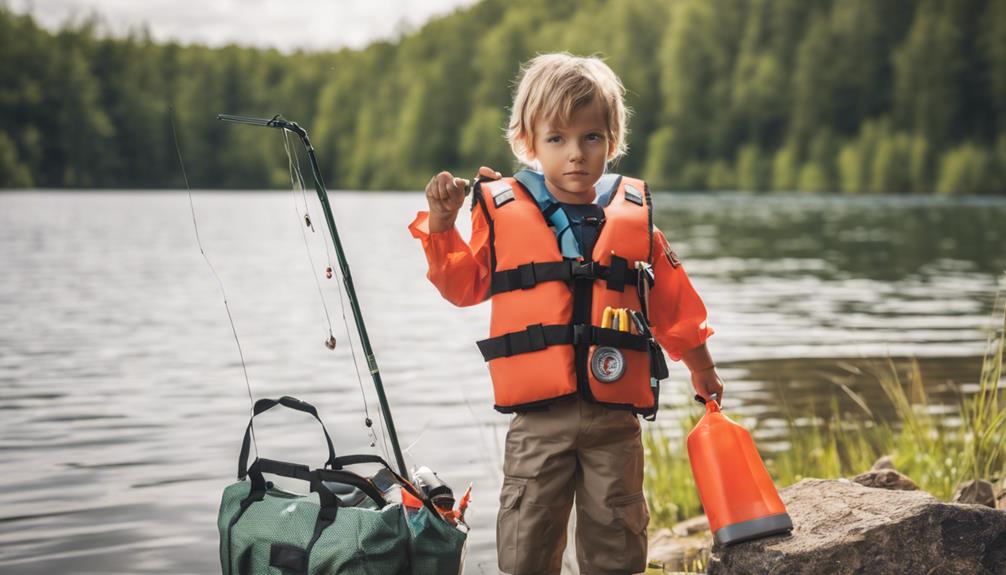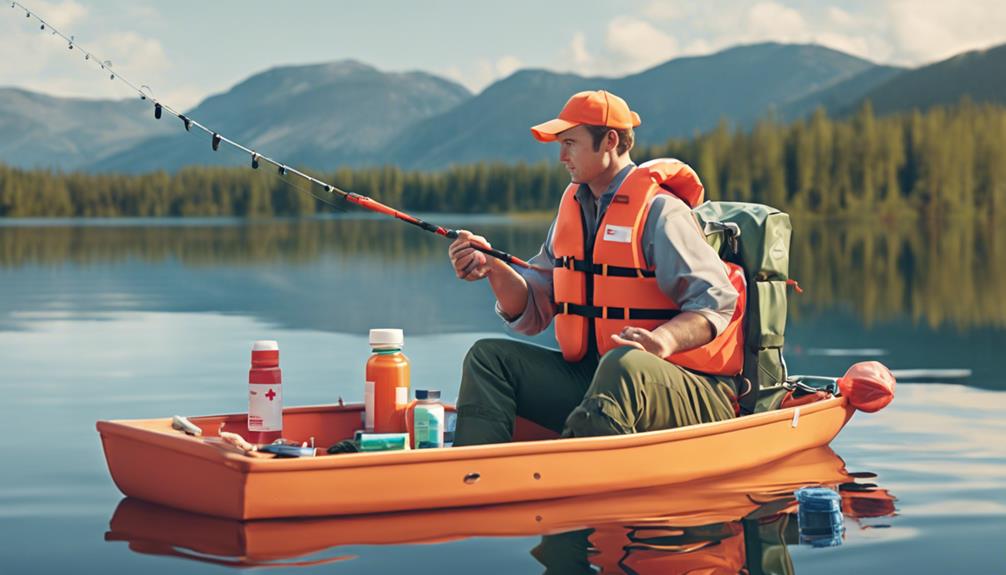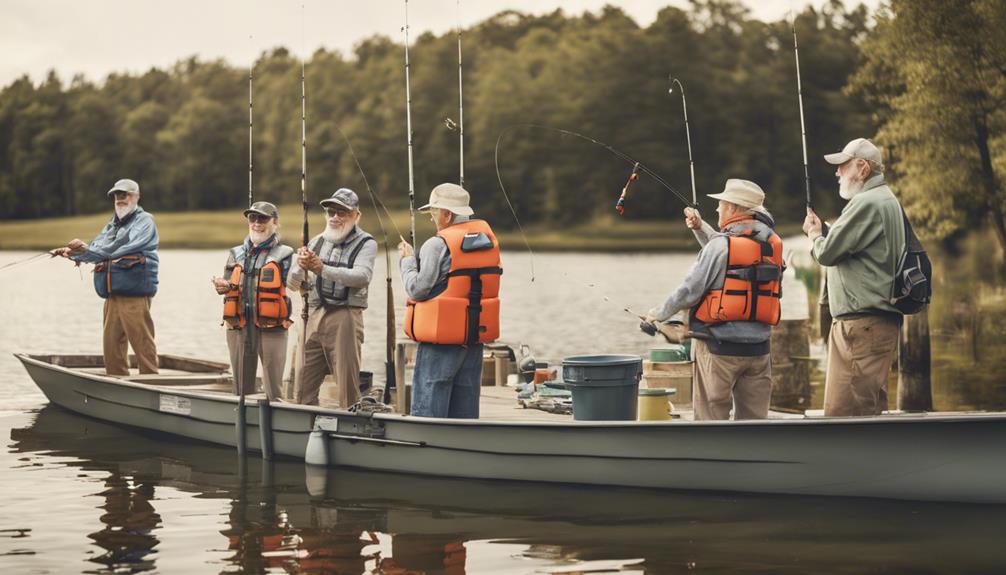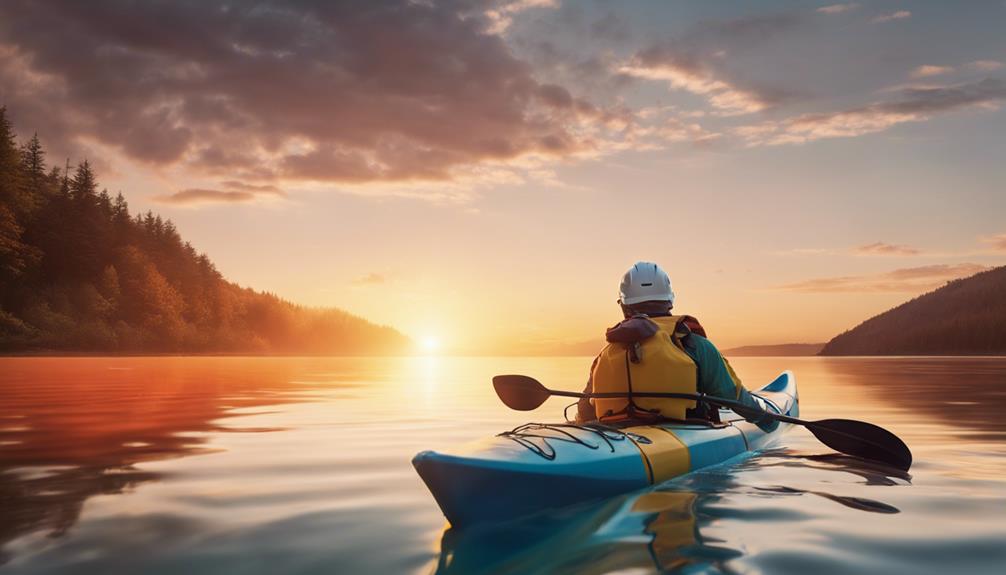When it comes to ensuring the safety of kids while fishing, there are essential guidelines that can't be overlooked. Imagine a fishing trip where every precaution has been taken to protect your little anglers.
From securing the right gear to instilling water safety awareness, each tip plays a crucial role in keeping your children safe by the water's edge. But there's more to discover beyond these basics that will further enhance their fishing experience.
Proper Gear and Equipment
When fishing with kids, ensure they've the proper gear and equipment to stay safe and enjoy the experience. Start by checking the gear's maintenance, ensuring everything is in good condition. Teach them the importance of keeping their gear clean and organized. Proper sizing is crucial for their comfort and safety. Ill-fitting gear can be uncomfortable and even dangerous, especially when it comes to life jackets or fishing rods.
Casting techniques are essential skills to master when fishing. Encourage your kids to practice casting in an open area before heading to the water. Show them how to hold the rod correctly, release the line smoothly, and aim for a specific spot. Practicing these techniques won't only improve their accuracy but also prevent any potential accidents while casting.
Additionally, make sure they've the right equipment for the type of fishing you'll be doing. Different fishing techniques require different gear, so explain to them the purpose of each item. Whether it's baiting a hook, tying a knot, or handling a fish, familiarize your kids with their gear and how to use it properly. By teaching them these skills and ensuring they've the right equipment, you'll set them up for a successful and safe fishing experience.
Sun Protection Measures
Ensure your kids are adequately protected from the sun's harmful rays by following these essential sun protection measures. When fishing, it's crucial to shield your child's delicate skin from the sun to prevent sunburns and long-term damage. Start by having them wear a wide-brimmed hat to shade their face, neck, and ears. This simple accessory provides excellent protection from direct sunlight.
Apply sunscreen liberally and frequently to all exposed skin areas. Choose a broad-spectrum sunscreen with a high SPF rating to safeguard against both UVA and UVB rays. Reapply every two hours, or more often if your child has been swimming or sweating. Don't forget to cover often-missed areas like the tops of ears, feet, and backs of hands.
Sunglasses aren't just a fashion accessory; they're essential for eye protection. Look for sunglasses that block 100% of UVA and UVB rays to shield your child's eyes from harmful sun exposure. Additionally, dressing your child in lightweight, long-sleeved shirts and pants made from UPF-rated fabric can offer extra protection.
Water Safety Awareness
To enhance your child's fishing experience and ensure their safety, it's vital to instill water safety awareness during your fishing outings. Water safety is crucial when engaging in any water-related activity, including fishing. One essential aspect of water safety for kids is wearing life jackets. Make sure your child wears a properly fitting life jacket at all times when near or on the water, even if they know how to swim. Life jackets are designed to keep children afloat and provide an extra layer of protection in case of accidents.
Additionally, consider enrolling your child in swimming lessons to improve their water skills. Knowing how to swim is a valuable life skill that can greatly enhance your child's safety around water. Swimming lessons not only teach children how to swim efficiently but also help them understand water safety rules and how to behave in different water conditions.
When fishing near bodies of water, always prioritize water safety. Even if the water seems calm, unexpected situations can arise. By teaching your child the importance of wearing a life jacket and providing them with swimming lessons, you're equipping them with the necessary tools to stay safe while enjoying their fishing adventures. Remember, water safety awareness is a key component of a fun and secure fishing experience for your child.
Supervision and Buddy System
For enhanced safety during fishing trips with kids, having proper supervision and implementing a buddy system is essential. When children are near water, ensuring they're under constant watch is crucial to prevent accidents. Here are some key points to consider:
- Parent Involvement: Parents should actively participate in fishing outings with their children. Being present allows parents to closely monitor their kids, offer guidance, and intervene in case of emergencies.
- Peer Monitoring: Encourage children to look out for each other. Implementing a buddy system where kids are paired up ensures that they watch over one another, promoting a sense of responsibility and teamwork.
- Setting Boundaries: Establish clear boundaries and rules for the fishing trip. Make sure kids understand where they can and can't go, emphasizing the importance of staying within designated safe areas.
- Communication: Maintain open communication with the children throughout the fishing excursion. Encourage them to speak up if they feel unsafe or if they notice any potential dangers, fostering a culture of awareness and proactive risk management.
Hook and Tackle Caution
When fishing with kids, remember to exercise caution when handling hooks and tackle to prevent accidents and injuries. Hook removal is a crucial skill to know when fishing with children. Always make sure to have a pair of pliers or a hook remover tool on hand to safely and efficiently remove hooks from fish or accidental snags. Teach kids how to properly handle hooks, emphasizing the importance of not touching the sharp points and being mindful of where the hook is at all times.
Additionally, bait selection plays a role in safety when fishing with kids. Opt for artificial baits or lures whenever possible, as they're generally safer to handle compared to live bait, which can be messy and pose a higher risk of accidental hooking. If using live bait, ensure that kids understand the proper way to hook the bait and the importance of keeping fingers away from the hook area.
Handling Fish Safely
Safely handling fish is essential to prevent injuries and ensure a positive fishing experience with kids. When teaching children how to handle fish properly, it's crucial to follow these tips:
- Hold the fish gently: Encourage kids to support the fish's body properly to avoid harming it. Use wet hands to prevent removing the protective slime layer that covers the fish.
- Use barbless hooks for catch and release: Opt for barbless hooks when planning to release the fish back into the water. This type of hook minimizes injury to the fish, making it easier to release them safely.
- Avoid squeezing the fish: Instruct kids to avoid squeezing the fish tightly to prevent harming its internal organs. Gentle handling is key to ensuring the fish remains healthy upon release.
- Release the fish properly: Teach children the correct way to release the fish back into the water. Hold the fish gently, facing it into the current, and allow it to swim away on its own to ensure a successful release.
Emergency Preparedness Kit

Creating an emergency preparedness kit is crucial for ensuring your safety while fishing with kids. When out on the water, unexpected situations can arise, making it essential to be prepared.
First aid is a fundamental component of any emergency kit. Pack items like bandages, antiseptic wipes, adhesive tape, and pain relievers to address minor injuries that may occur during your fishing trip. Additionally, including medications that your child may need is vital for their well-being.
Communication devices are also key elements of your emergency preparedness kit. In case of emergencies, having a reliable way to communicate with others can make a significant difference. Consider bringing a fully charged cell phone, a whistle, or a signaling mirror. These tools can help you attract attention and call for help if needed. Teach your child how and when to use these devices, ensuring they understand their purpose.
Respect Nature and Wildlife
Ensure that your interactions with nature and wildlife while fishing with kids are respectful and mindful of their habitats. It's crucial to instill in children a sense of wildlife appreciation and environmental conservation from a young age.
Here are some tips to help you and your kids respect nature and wildlife while fishing:
- Practice Catch and Release: Teach kids the importance of catch and release to help preserve fish populations and maintain the ecosystem's balance.
- Dispose of Waste Properly: Always clean up after your fishing trip, disposing of any garbage or fishing line in designated bins to prevent harm to wildlife.
- Observe from a Distance: Encourage children to observe wildlife from a distance without disturbing their natural behavior or habitats.
- Learn about Local Wildlife: Take the time to educate kids about the different species of wildlife they might encounter while fishing, fostering a deeper understanding and appreciation for nature.
Frequently Asked Questions
Can Children With Food Allergies Safely Participate in Fishing Activities?
If you have food allergies, you can safely participate in fishing activities. Make sure to bring allergy-friendly bait and inform your fishing companions about your allergies.
Take angling precautions by washing your hands after handling bait and avoiding touching your face.
With these food allergy accommodations and fishing safety measures in place, you can enjoy a fun and safe fishing experience.
How Can Kids With Mobility Limitations Still Enjoy Fishing Safely?
If you have mobility limitations, there are ways to enjoy fishing safely. Adaptive equipment like fishing rod holders and accessible fishing piers can make the experience more manageable.
Look for lakes or ponds with smooth paths and wheelchair ramps for better accessibility options. With these tools and locations, you can still have a great time fishing while ensuring your safety.
Are There Any Specific First Aid Tips for Dealing With Common Fishing-Related Injuries in Children?
When it comes to preventing burns and cuts, it's important to be prepared. Always have a first aid kit handy with supplies like bandages, antiseptic wipes, and burn cream.
Teach kids how to properly handle fishing equipment to avoid injuries. In case of cuts, clean the wound with soap and water, apply pressure to stop bleeding, and cover with a bandage.
For burns, immediately cool the affected area with water and seek medical attention if severe.
How Can Parents Help Kids Stay Focused and Patient While Fishing?
To help your kids stay focused and patient while fishing, try using mindfulness techniques like encouraging deep breathing.
Positive reinforcement works wonders too; consider setting up a rewards system for their efforts.
By staying calm and giving gentle reminders, you can create a positive fishing experience for your children.
What Are Some Fun and Educational Activities Kids Can Do While Waiting for a Fish to Bite?
While waiting for a fish to bite, you can keep kids entertained with nature scavenger hunts and bird watching.
To make it educational, try fish identification or watercolor painting.
These activities not only pass the time but also teach kids about the environment and help them appreciate nature.
It's a great way to make waiting for that big catch more enjoyable and enriching for the little ones.
Conclusion
Remember, fishing can be a fun and rewarding activity for kids, but it's important to prioritize safety at all times.
By following these 8 safety tips, you can help ensure that your child has a safe and enjoyable fishing experience.
Always be prepared, stay aware of your surroundings, and respect nature and wildlife while out on the water.
With the right precautions in place, fishing can be a great way for kids to learn and explore the outdoors safely.



